How to Arrange Furniture in a Long Living Room (2025)
Do you have an awkwardly shaped living room? I do too. Here are 8 simple layouts that will work perfectly as we discuss how to arrange furniture in a long living room!
My living room is long and narrow with many obstacles. We have a hallway that cuts through it, a wall of windows, and an opening to the entryway. However, awkward shaped living rooms don’t have to feel awkward.
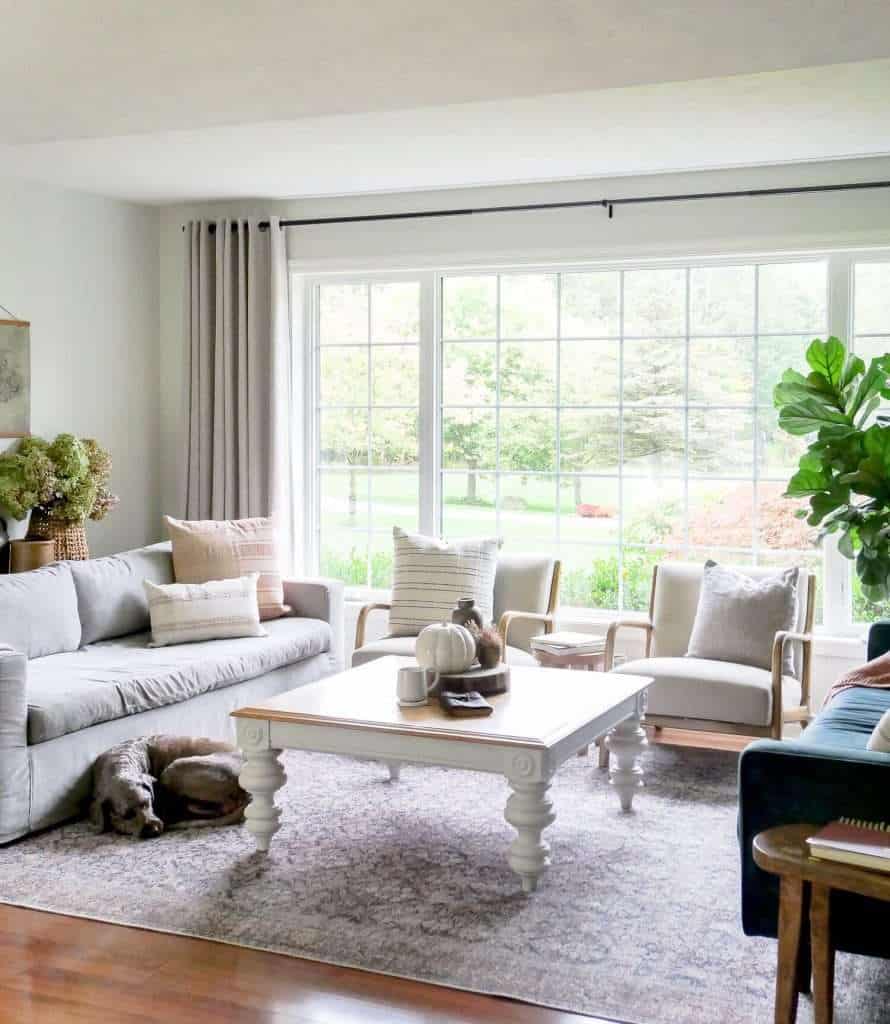
This post contains affiliate links for your convenience.
How to Arrange Furniture in a Long Living Room
When Aaron and I purchased our previous home, I immediately saw the challenge of arranging furniture in our long, narrow living room. There were several obstacles to work around that made it especially challenging.
- Multiple entry and exit points
- Hallway cuts the room in half
- Open layout concept with no definition
- Attached to an open entryway
- Full wall of windows
- Narrow width
- Multiple focal point options

Over the five years we lived there, our living room saw multiple layout options. All of them “worked” and were viable options for our personal space.
But as we rearranged the living room furniture, had different seating needs, and slowly changed my design style, new configurations emerged.
Today, I’m sharing what to consider when arranging living room furniture, how to define an awkward space and how to design for functionality.
At the end, I’ll be sharing how I designed our long living room addition in our current home as well.
7 Things to Consider When Arranging Living Room Furniture
There are a variety of things to consider when designing a living room layout. Here are the top 7 to give you a start.
- Overcoming obstacles
- Room focal point
- Flow
- Seating needs
- Purpose of the room
- How to define the space
- Adding zones
First, do you need to overcome any obstacles? For instance, our living room and entryway are essentially one long space. So we needed to create a division somehow.
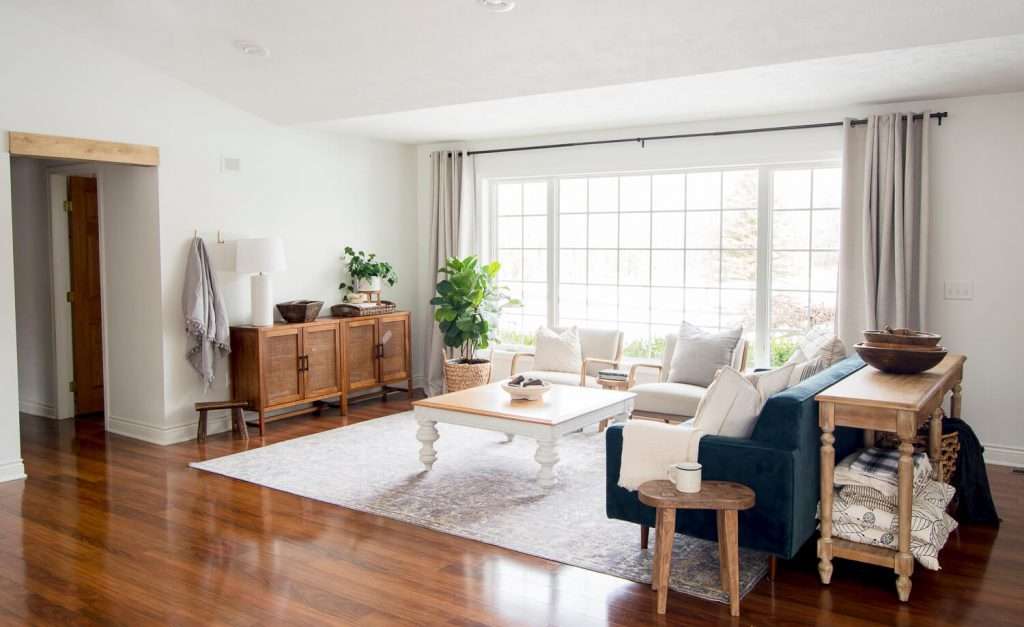
Shop This Look
SHOP THE LOOK
Second, what do you want the room’s focal point to be? Many people design furniture layout around a focal point. Examples of this would be a fireplace, TV, or conversation area.
Third, how does the flow of the room work? When arranging furniture, you want to have a natural flow (walking pathway) through the room so people aren’t tripping over furniture to use the space.
Fourth, what are your seating needs? Can you get away with one small loveseat and a couple of arm chairs? Or do you need a full sectional with tons of seating?
Fifth, what is the purpose of the room? Will you be using it as an everyday family room, formal living room, entertaining space, home office…etc?
Sixth, how will you define the space? Many homes are open concept with no walls to create a defined living room. So you will want to define the space with either your furniture layout or an area rug.

Finally, consider adding zones.
Long narrow living rooms can be seen as difficult to design, but they actually offer you the opportunity to create living zones within one space. One zone could be a conversation area, the next a game table, the next storage…etc. It simply depends on your needs!
Living Room Design: Out of the Box Thinking
Once you’ve considered the above items, it’s time to put together a living room design! There are three design staples in creating a functional and defined living space.
- Pull furniture off the wall
- Design vertically
- Create zones
Allow Furniture to Float
One design mistake I often see when arranging furniture in a long narrow room is placing all the furniture along an outside wall.
There is a misconception that furniture must be placed on a wall. Perhaps that stems from older style homes where rooms were actually defined by walls. However, in our open concept society, walls aren’t always an option!
Instead, in these types of spaces it is best to allow furniture to float when you’re able.
Of course there will be times when the narrowness of the room doesn’t allow this for every piece, but then you can choose wisely what to place along a wall.
When you allow furniture to float, it makes a room feel more intimate and intentional. I talk a bit more about this in my YouTube video on designing a functional family room.
Design Vertically When Able
Next, since you are working with a narrow footprint, design vertically.
How can you use the vertical space in the room to gain more storage, places to display decor, or to draw the eye upward for interest?
Here are a few options:
- Tall built in storage cabinets to create functionality with high design
- Narrow consoles with open shelving above for decor display
- Large-scale artwork to draw the eye to a focal point
- Wall millwork to add interest without taking up floor space (check out how I did this in our basement living space)
Define Zones
And lastly, use area rugs and furniture layout to define a living room zone.
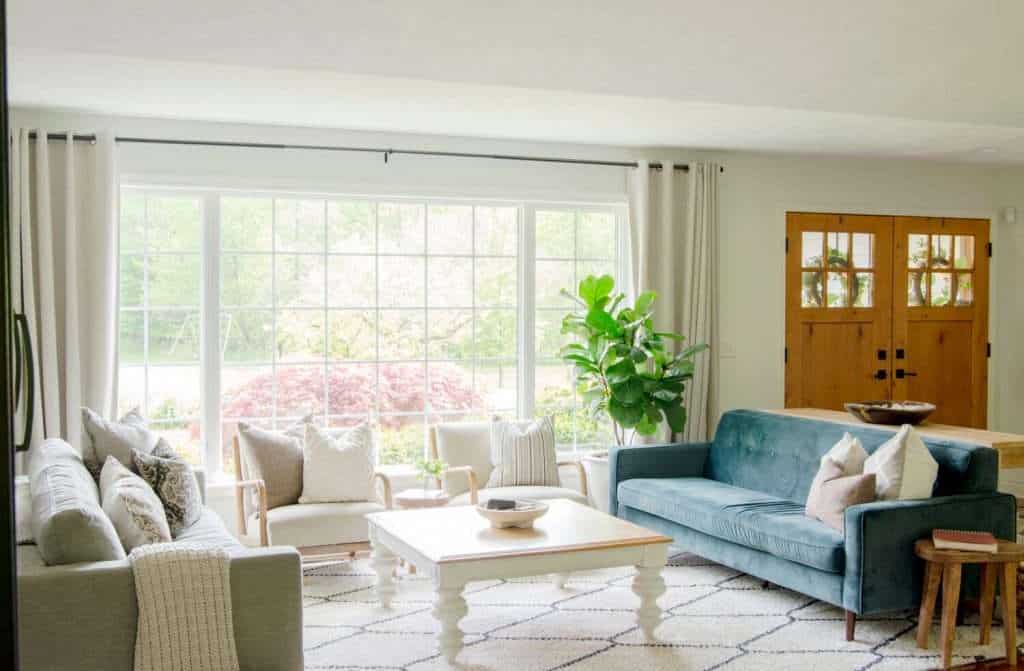
Since our living room is open to the entryway, kitchen, and walkways, I used one large area rug to define the space. The area rug then defines where our living room furniture can live and acts as “walls”.
Additionally, a long console table behind one sofa defines the living room from the entryway space. Using rugs and furniture to give an open concept living room definition is the easiest route to go!
8 Long Narrow Living Room Layout Options
Now that you have your wheels turning, let’s dive in to 8 common living room layouts that will work for long living rooms.
Living Room Layout 1: Two Sofas & Arm Chairs
The first layout option is the one I currently have in my own living room. Two sofas and two armchairs.

We eventually evolved our living room to add a second full sofa because we were hosting small groups and enjoy entertaining. We needed the seating!
The one wall we have in our living room is only wide enough to hold one sofa. So the layout is built off that sofa and down the room.
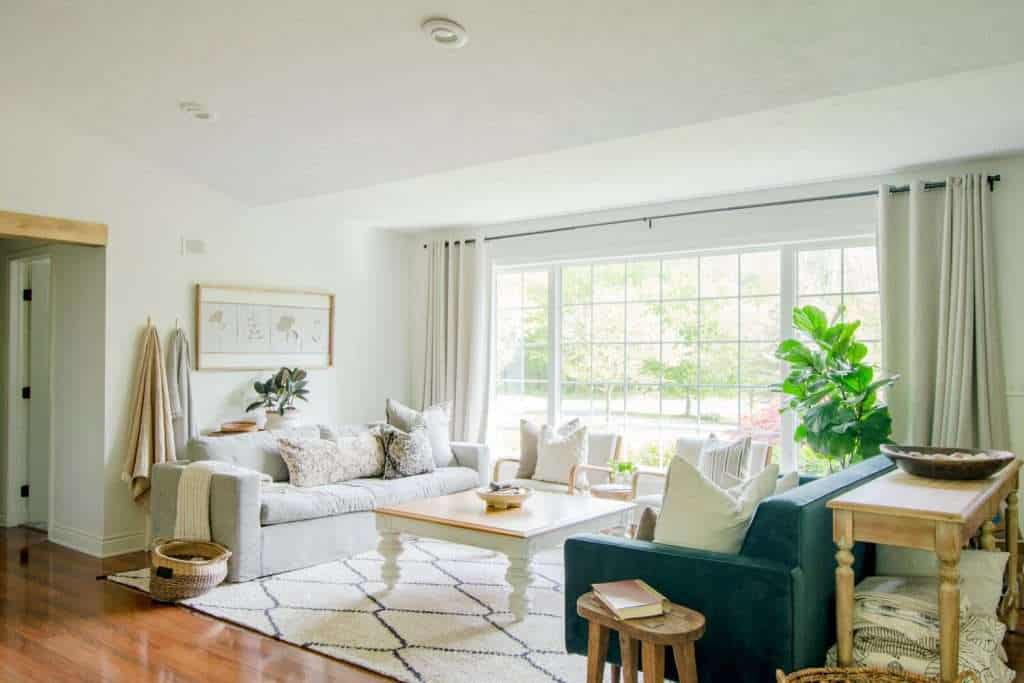
Shop This Look
SHOP THE LOOK
As you can see, the area rug defined the zone. This allows the walkway to the hallway to stay unimpeded. Then, the long console table on the right divides the living room from the entryway.
Both sofas are floating with skinny tables behind them for decor or simply a place to put coffee cups.
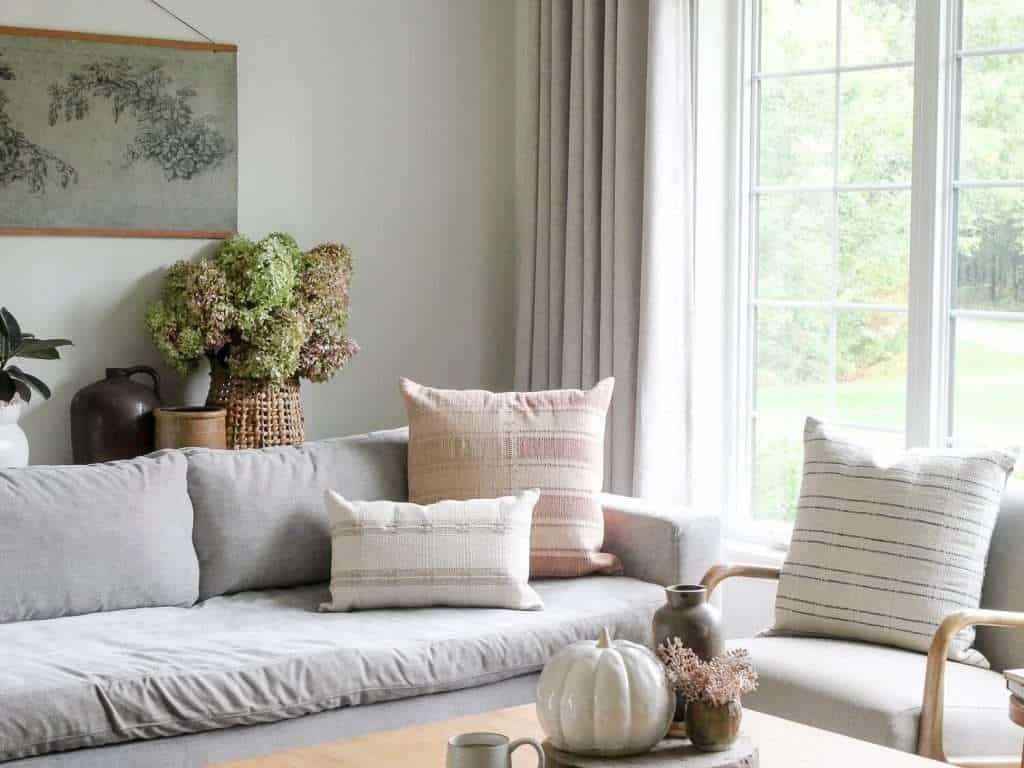
Shop This Artwork
This layout is the most cramped since it is a lot of furniture in a small space. However, I was able to make sure that the coffee table and surrounding seating had at least 16 inches of leg/walking space.
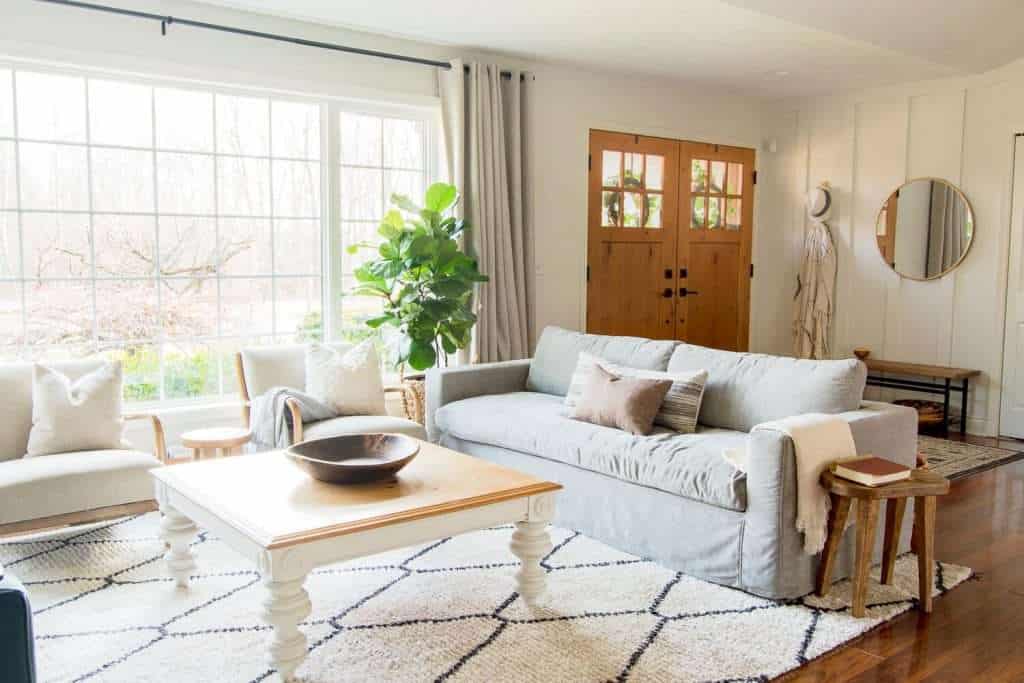
This is a general rule of thumb that allows you to walk freely, yet use the coffee table easily when seated.
Living Room Layout 2: 1 Sofa & 2 Arm Chairs
A few years ago, we were keeping it simple with one sofa and two arm chairs.

This allowed us the most walking space with the largest piece of furniture on the window wall.
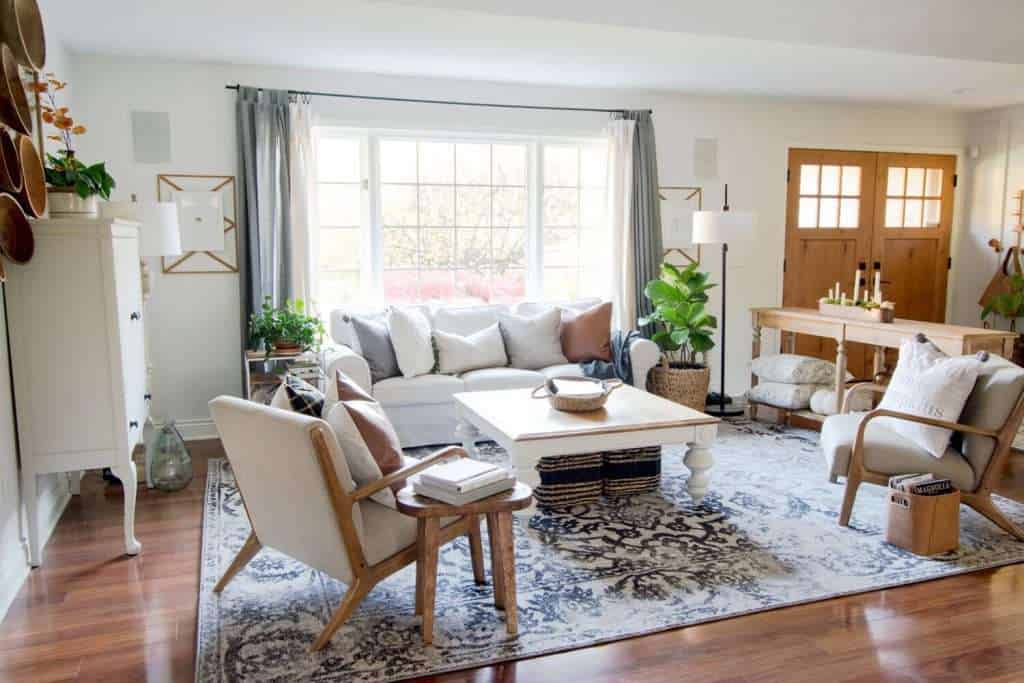
It also provided a more intimate conversational area as all the furniture pointed inward. This is a great option for formal living rooms that don’t require a lot of seating.
Living Room Layout 3: Adding Storage
Layout 2, above, has a tall storage cabinet. However, here is another layout option that allows for added storage.

Depending on your needs, you can arrange living room furniture to have open access to storage, or have it be more tucked away.
In layout 3, I needed my kids to have access to their homeschool materials daily while we were shut down during the pandemic.
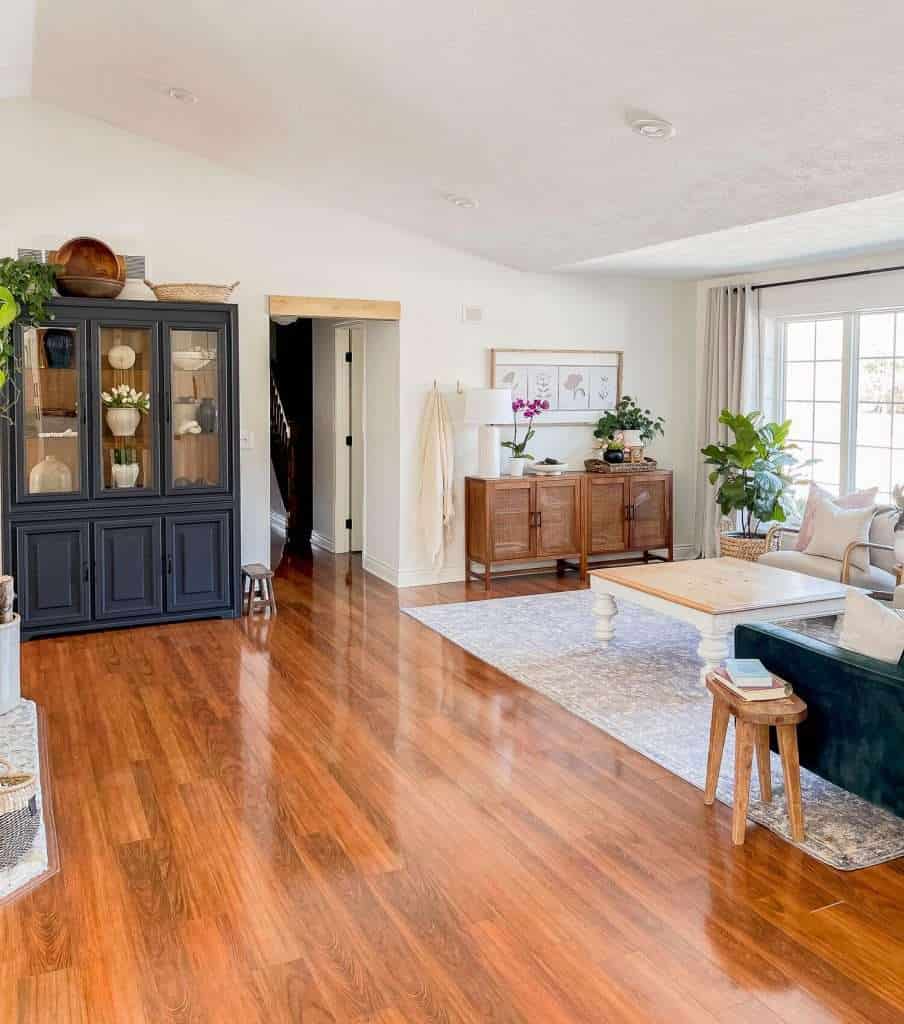
So, I rearranged our furniture to accommodate this storage console that wasn’t impeded by anything else.
This is a great example of function over form. The functionality of the space trumped the design form I would naturally be drawn to. And it worked perfectly for our needs during that time.
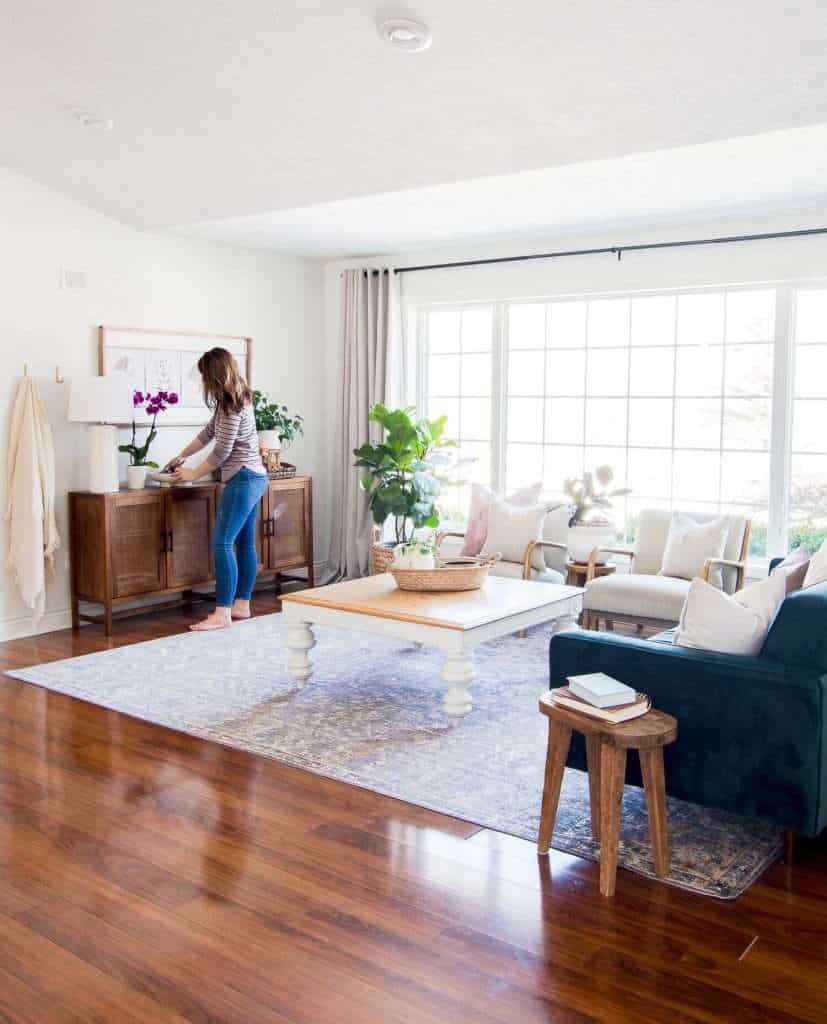
SHOP THE LOOK
Living Room Layout 4: Layered Look
Another option is to add in layers as you arrange furniture in a long living room.
Rather than creating structured zones, you can soften a room with layers.

Once my kids were back in school and didn’t need daily access to their storage cabinet, I added some layers back into the room.
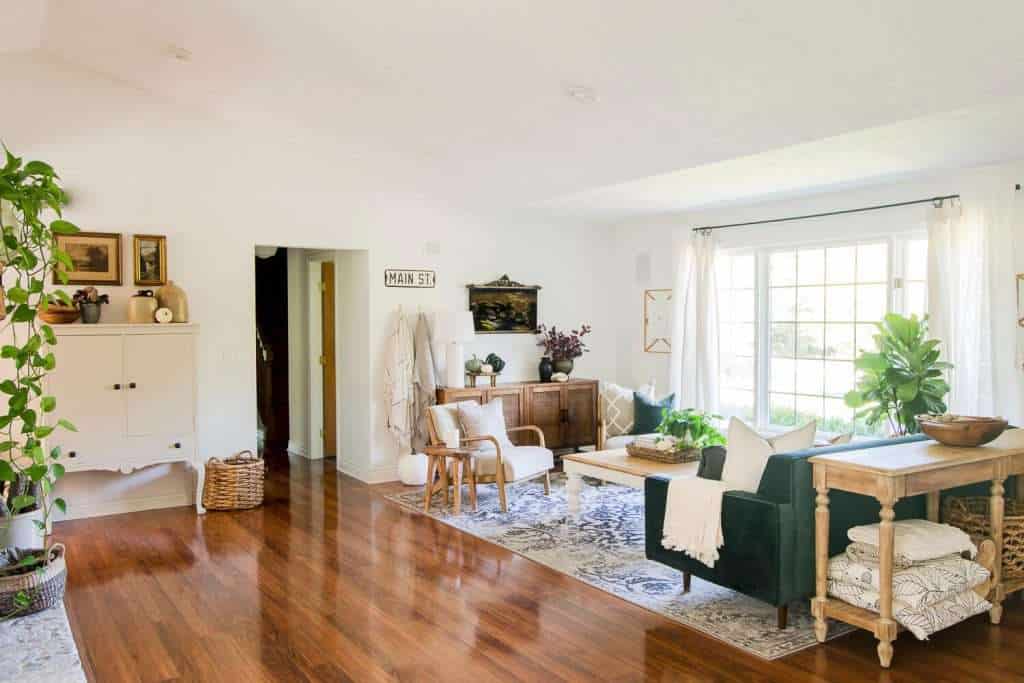
I was able to create a better conversation area again by pulling the arm chairs off the window and layering them in front of the storage cabinet.
While the cabinet is still accessible, it creates less of a focal point on the cabinets and more on an intimate setting.
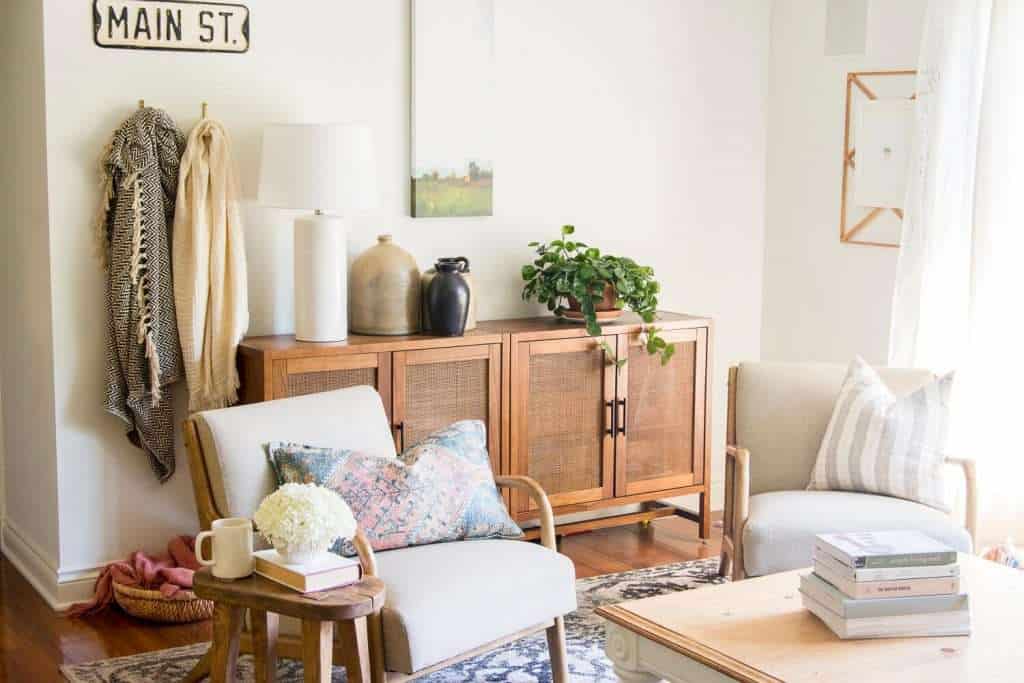
Living Room Layout 5: Create Zones
Like we discussed above, it’s always a great use of space to create zones when designing a long narrow room.

In my room, my zones have changed as the furniture layout has changed with our functional needs.
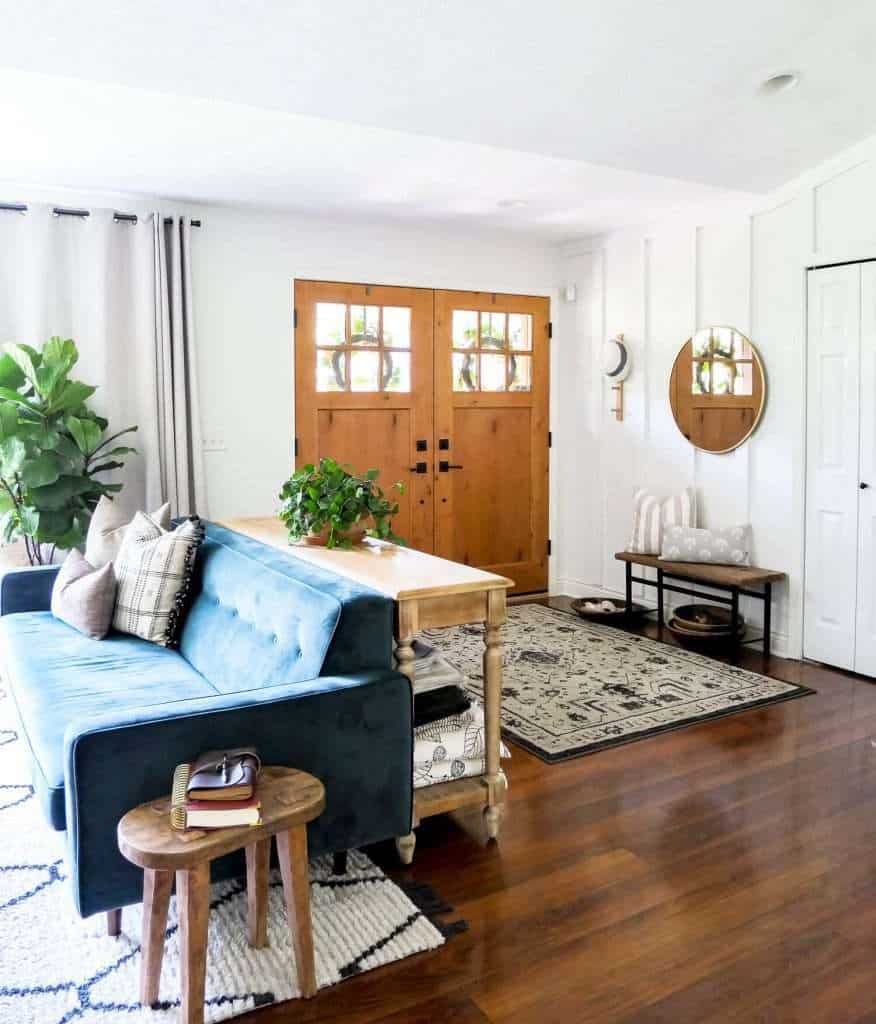
However, our main zone has always been defining our entryway.
The rest of the space is zoned by conversation area, storage or schooling needs.
If you have a particularly long living room, you can add zones with purposes such as entertaining seating, game, TV, or reading nooks.
Living Room Layout 6: L Shaped
The final common living room furniture arrangement is in an L shape.
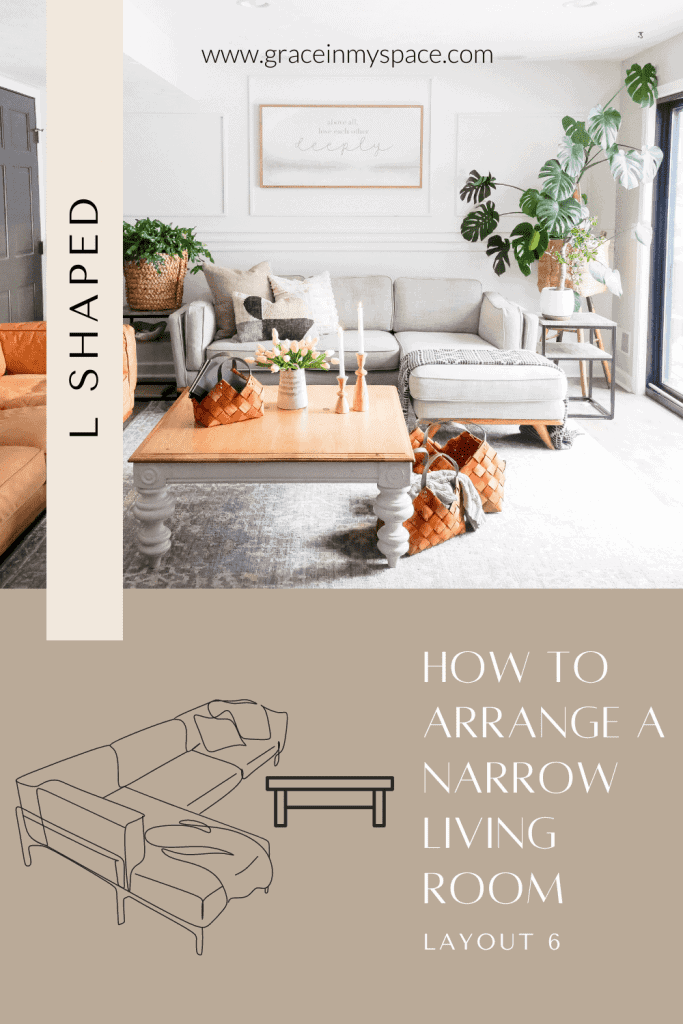
You can do this in a variety of ways.
- Chaise sectional
- Traditional sectional
- Placing sofa and arm chairs in an L shape
- Extending sofas with side tables to create an L
The benefit of L shapes in long narrow living rooms is that it utilizes the length of the room well.

You can learn more about this layout in this post on designing a basement family room.
Living Room Layout 7: Centered
As you can see, for years I kept our long living room pushed to one side so it didn’t impede the entrance to the hallway.
However, over time I found it made more sense to center the layout in the full room and walk “through” the furnishings.
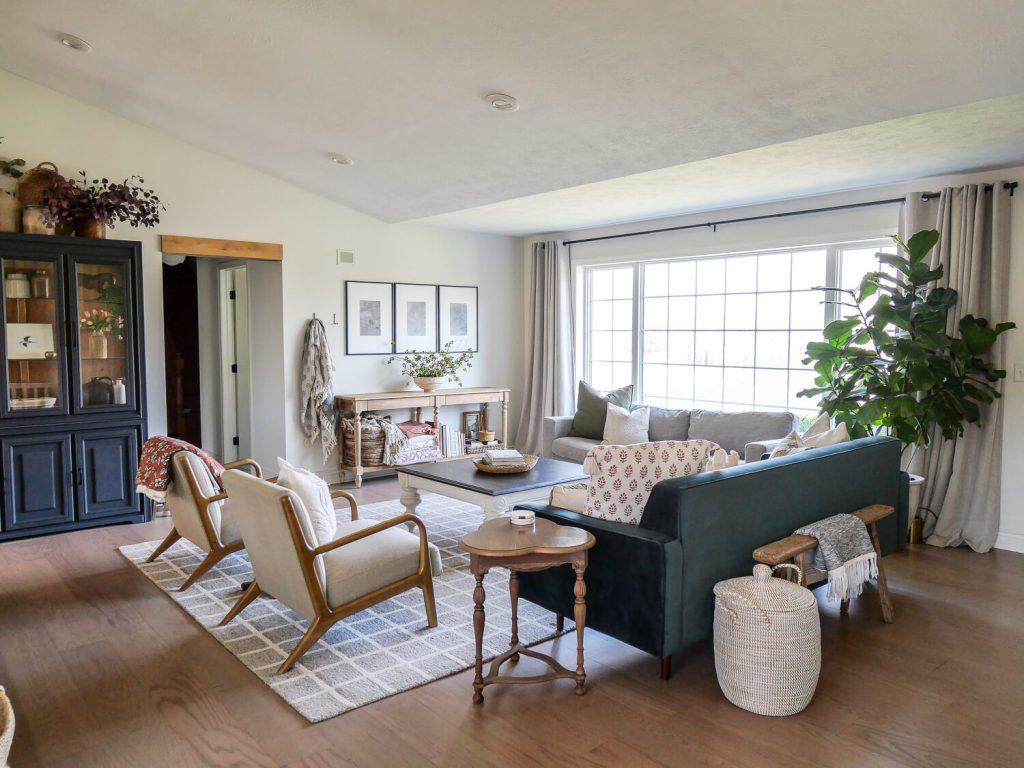
This allows so much more use of space and created a more cohesive layout with the stone fireplace we added.

For years I thought I should keep the hallway unimpeded. But it turns out, you don’t always have to create the path of least resistance to a hallway or entrance.
It is just as easy to walk along the path the area rug creates and spreads out the furniture in a much better scale for the room.
Designing a Long Living Room Addition
For the 8th long living room layout, let’s journey to our current home!
We’ve completed our living room addition!
While decorating a long living room may be a challenge, I prefer to work with a long narrow space. In fact, that’s exactly how I designed our long living room addition.
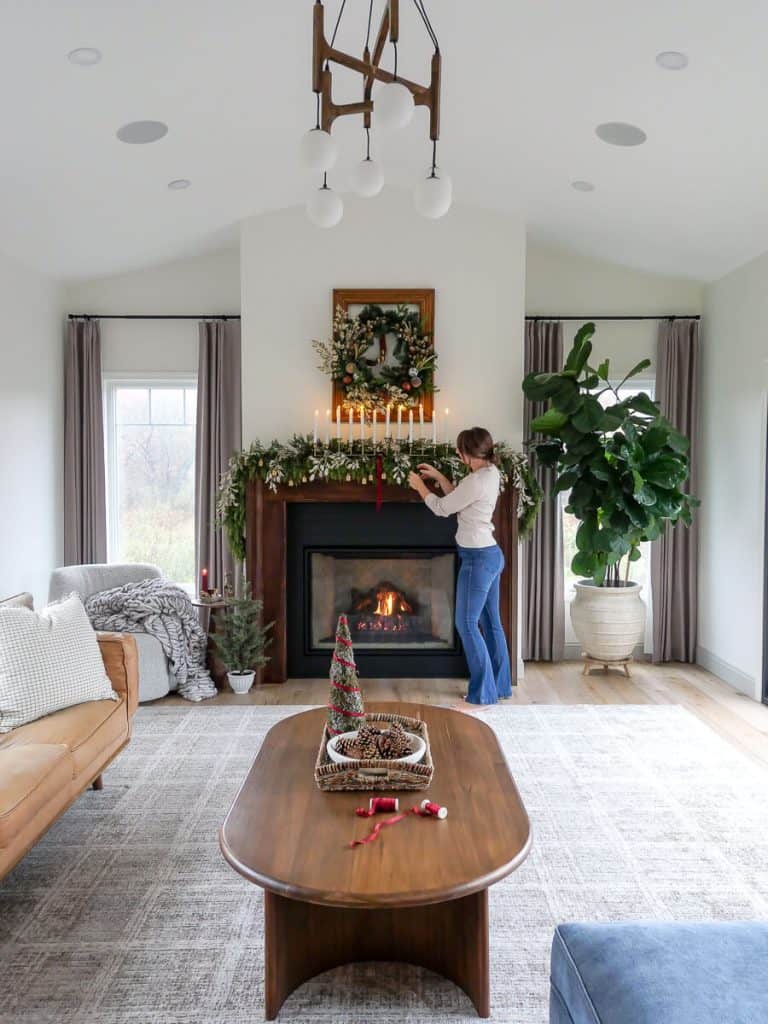
SHOP THE LOOK
This layout has a focal point of the fireplace with the furniture situated in an L, pointing at the fireplace.
While it also has openings to the outdoors, it was easy to design the space to have one focal point for the furniture to point towards.
You can see more of this living room layout here.
How to Decorate a Narrow Living Room
Now that you have some ideas for how to arrange furniture in a long living room, let’s decorate!
Living rooms are often a central hang out space, or a place where guests are welcomed. So you want it to convey a welcoming atmosphere and be cohesive with the rest of your home.
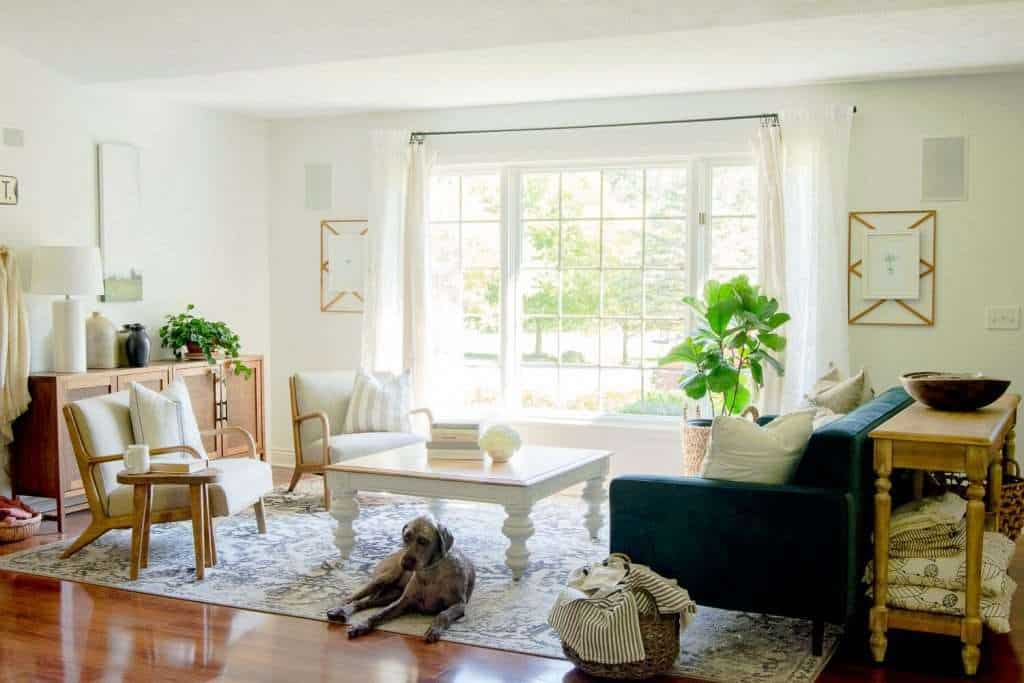
If you aren’t sure how to go about defining your decorating style, make sure to check out my two part series on YouTube.
- How to Define Your Decorating Style
- How to Implement Your Decorating Style
Start with this video!
I like to keep the living room decor fairly basic and uncluttered. This is my personal style!
Others may love a more collected or eclectic look. Decorating is such a personal action because it should reflect the homeowner.
It isn’t a one-size-fits all formula.
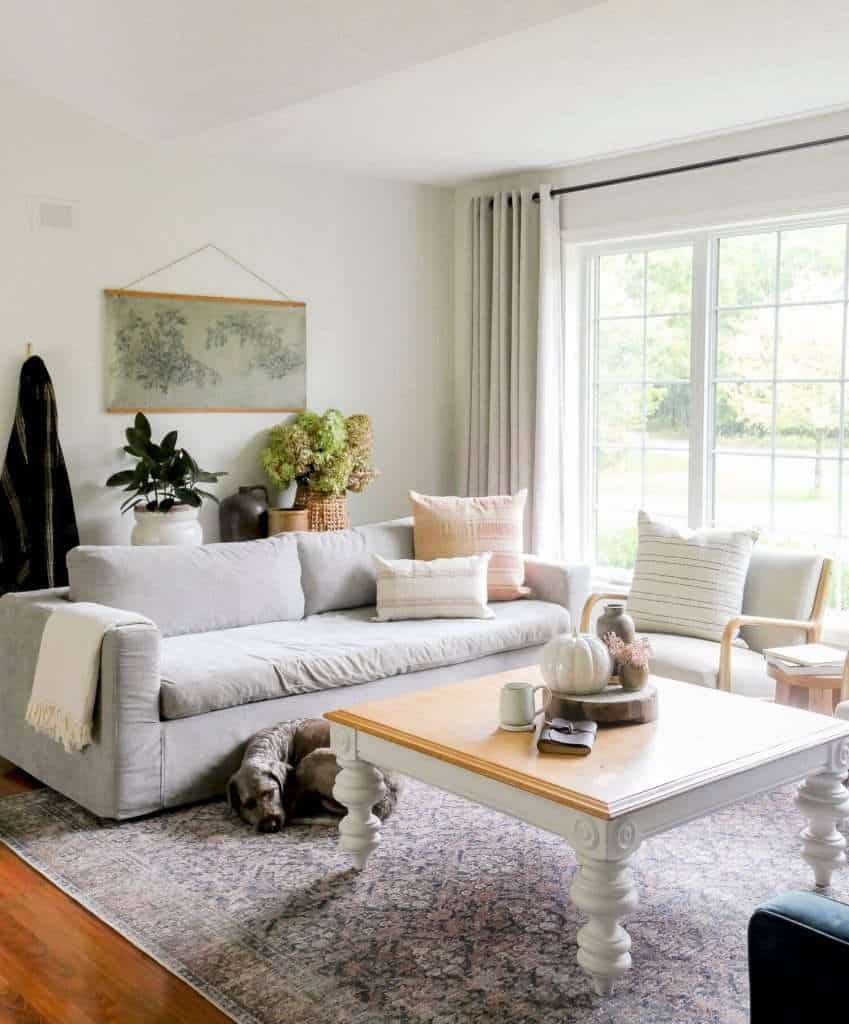
If you want to gain more knowledge on how to design a room from scratch, make sure to check out this three part series on a complete guide to creating spaces you love.
Additionally, you can also learn more about some specific design styles I’ve used in my living room over the years below.
- Organic Modern Living Room Design
- Modern Bohemian Living Room Design
- Mid Century Modern Living Room Design
- Modern Farmhouse Living Room Design
- Vintage Farmhouse Living Room Design
If you’re looking for how to decorate a large family room, you can see how we’ve designed our family room in these posts.
More Living Room Inspiration
I hope that this article on how to arrange living room furniture in a narrow living room has been helpful to you!
Thanks so much for stopping by the blog today. I’d love for you to leave any questions you have in the comments!
Make sure to subscribe to get my Grace Notes directly to your inbox and to access all my insider perks. You can also follow along daily on Instagram and weekly on YouTube!
~Sarah
Living Room Design Ideas
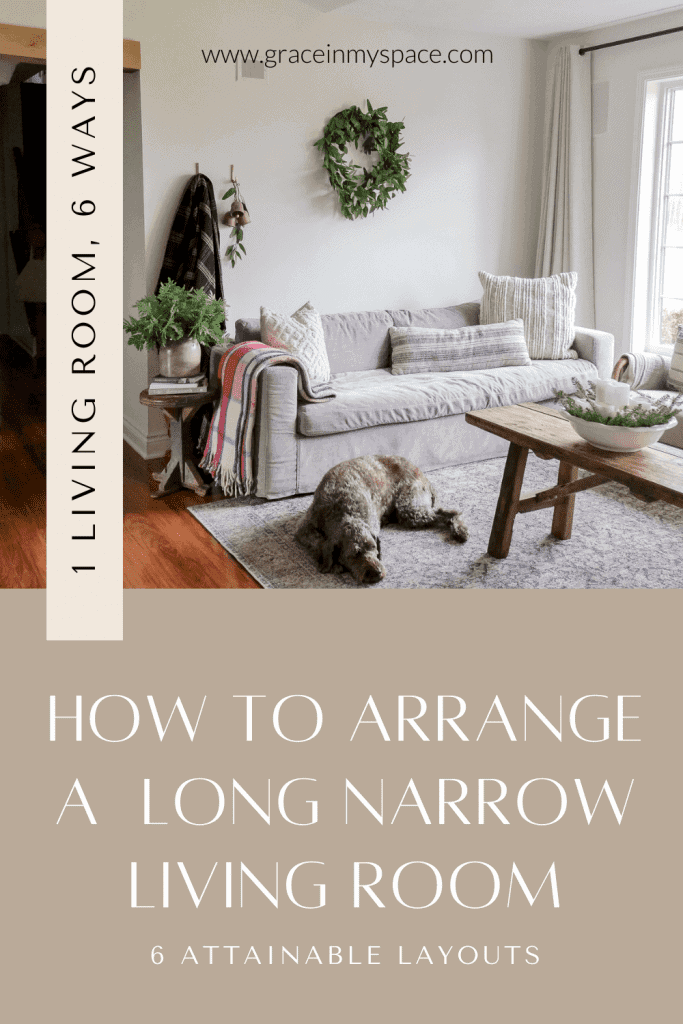



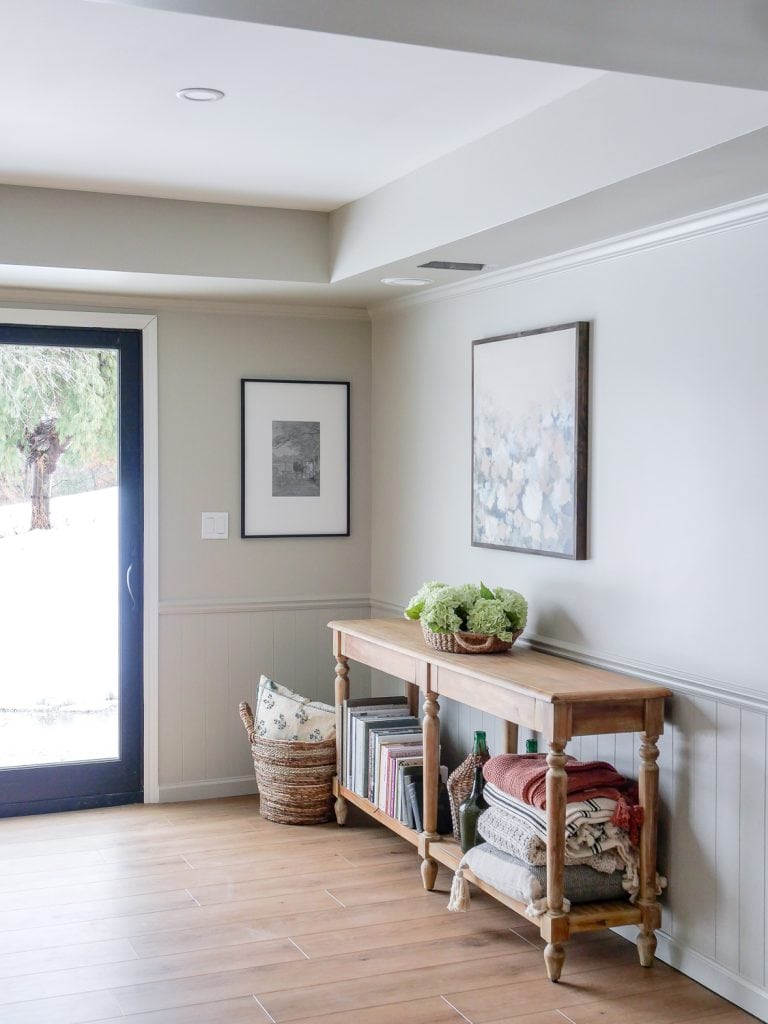
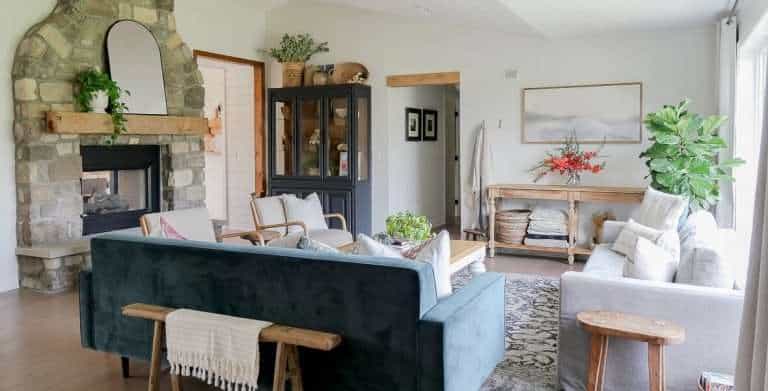


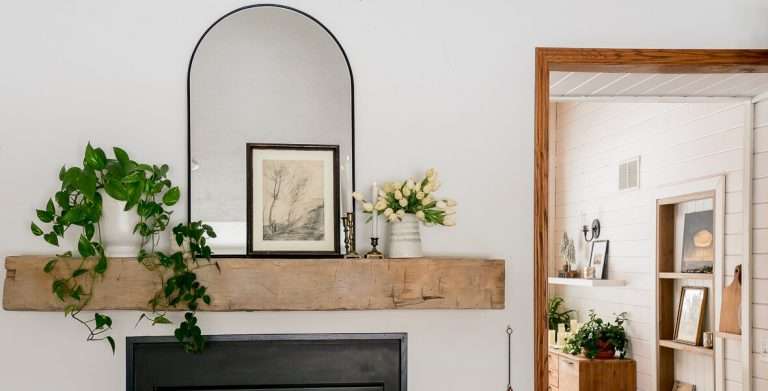
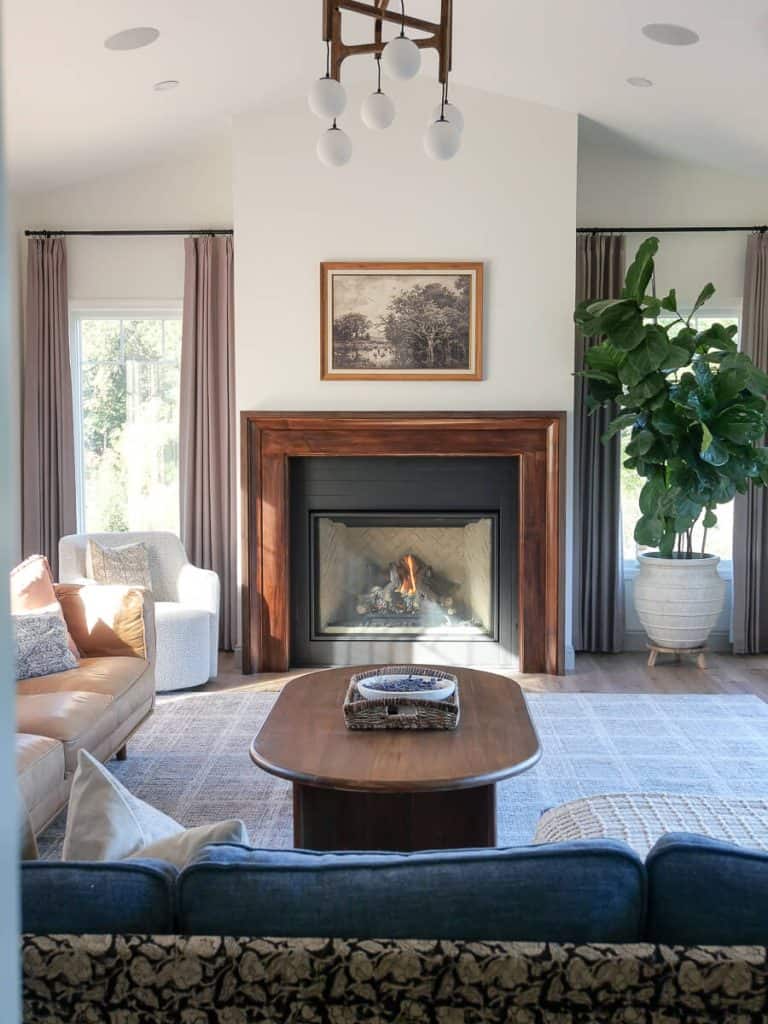
My living room is long and narrow with many obstacles. We have a hallway that cuts through it, a wall of windows, and an opening to the entryway. However, awkward shaped living rooms don’t have to feel awkward.
Hello! I love your coffee table. Can you please let me know what the dimensions for it are and/or where I might find a similar one? Thank you!
Hi Jess! This was actually a Facebook marketplace find that I redid. I like to make sure there are at least 2 feet between sofas or chairs and the coffee table. Hope that helps with finding dimensions that will work for your space!
I would love to know what color your tall hutch is… it looks dark blue or gray but I can’t tell.
It is called Black by Rustoleum Studio Color from Walmart.
Thanks for such an amazing post. Thanks man!
Appreciate able Post… Thanks alot!!
This article offers practical and stylish solutions for arranging furniture in a long living room, making the most of the space while maintaining functionality and flow.
This is such a helpful guide for arranging furniture in a long living room! The tips on defining spaces, creating flow, and choosing a focal point are especially useful. Love the practical approach and layout ideas!
Happy to Visit Your Blog Article about Arrange Furniture!!
The decoration is very beautiful, thank you for your good article
I love your ideas for this type of room. Very inspirational; I really appreciate the detail and homely designs you have given to each look. I especially like layout number one, with the two sofas very nice, as most of the people seated can see the lovely view out of the window.
Thanks for sharing.
From the UK.
I see no lighting in any of these layouts, except overhead cans and one floor lamp. Would love to see ideas for using table lamps when floating furniture. Hiding cords? What to do if you don’t have/can’t add floor outlets. Thanks.
Thanks for sharing informative article
I’d love to know where you purchased your wood and upholstery chairs, now the height of those and coziness
Thank you for these suggestions. Will be looking forward for other contents and recommendations.
I would love to know what color your tall hutch is… it looks dark blue or gray but I can’t tell.
It is called Black by Studio Color found at Walmart. It does pull navy in the right light!
This was the kind of thing I was searching for, truly accommodating, and incredible work done. Continue to share incredible substance like this.